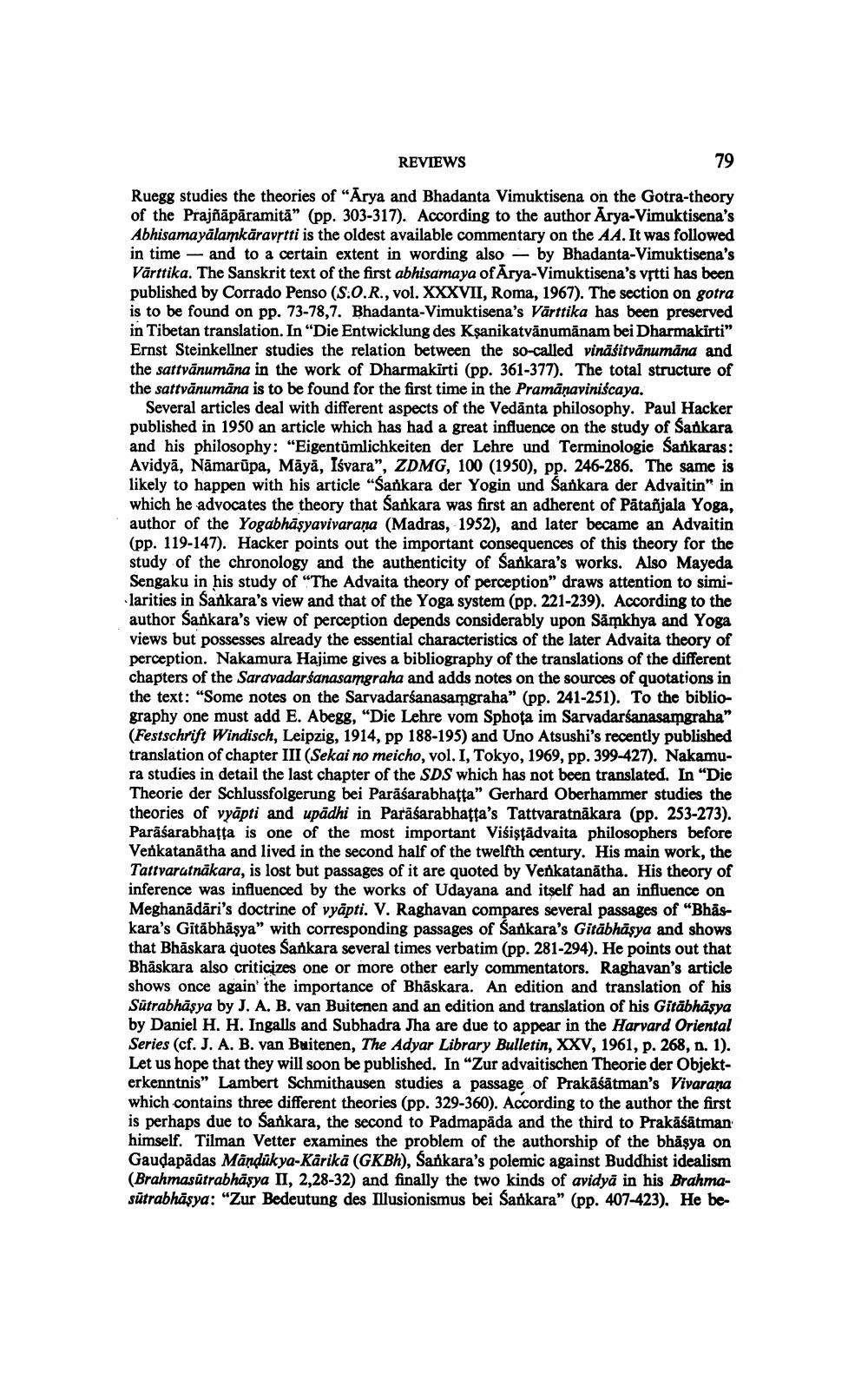Book Title: Reviews Of Different Books Author(s): Publisher: View full book textPage 3
________________ REVIEWS 79 Ruegg studies the theories of "Arya and Bhadanta Vimuktisena on the Gotra-theory of the Prajnaparamita" (pp. 303-317). According to the author Arya-Vimuktisena's Abhisamayalamkaravstti is the oldest available commentary on the AA. It was followed in time -- and to a certain extent in wording also -- by Bhadanta-Vimuktisena's Varttika. The Sanskrit text of the first abhisamaya of Arya-Vimuktisena's vstti has been published by Corrado Penso (S.O.R., vol. XXXVII, Roma, 1967). The section on gotra is to be found on pp. 73-78,7. Bhadanta-Vimuktisena's Varttika has been preserved in Tibetan translation. In "Die Entwicklung des Ksanikatvanumanam bei Dharmakirti" Ernst Steinkellner studies the relation between the so-called vinasitvanumana and the sattvanumana in the work of Dharmakirti (pp. 361-377). The total structure of the sattvanumana is to be found for the first time in the Pramanaviniscaya. Several articles deal with different aspects of the Vedanta philosophy. Paul Hacker published in 1950 an article which has had a great influence on the study of Sankara and his philosophy: "Eigentumlichkeiten der Lehre und Terminologie Sankaras: Avidya, Namarupa, Maya, Isvara", ZDMG, 100 (1950), pp. 246-286. The same is likely to happen with his article "Sankara der Yogin und Sankara der Advaitin" in which he advocates the theory that Sankara was first an adherent of Patanjala Yoga, author of the Yogabhasyavivarana (Madras, 1952), and later became an Advaitin (pp. 119-147). Hacker points out the important consequences of this theory for the study of the chronology and the authenticity of Sankara's works. Also Mayeda Sengaku in his study of "The Advaita theory of perception" draws attention to similarities in Sankara's view and that of the Yoga system (pp. 221-239). According to the author Sankara's view of perception depends considerably upon Samkhya and Yoga views but possesses already the essential characteristics of the later Advaita theory of perception. Nakamura Hajime gives a bibliography of the translations of the different chapters of the Saravadarsanasamgraha and adds notes on the sources of quotations in the text: "Some notes on the Sarvadarsanasamgraha" (pp. 241-251). To the bibliography one must add E. Abegg, "Die Lehre vom Sphota im Sarvadarsanasamgraha" (Festschrift Windisch, Leipzig, 1914, pp 188-195) and Uno Atsushi's recently published translation of chapter III (Sekai no meicho, vol. I, Tokyo, 1969, pp. 399-427). Nakamura studies in detail the last chapter of the SDS which has not been translated. In "Die Theorie der Schlussfolgerung bei Parasarabhatta" Gerhard Oberhammer studies the theories of vyapti and upadhi in Parasarabhatta's Tattvaratnakara (pp. 253-273). Parasarabhatta is one of the most important Visistadvaita philosophers before Venkatanatha and lived in the second half of the twelfth century. His main work, the Tattvaratnakara, is lost but passages of it are quoted by Venkatanatha. His theory of inference was influenced by the works of Udayana and itself had an influence on Meghanadari's doctrine of vyapti. V. Raghavan compares several passages of "Bhaskara's Gitabhasya" with corresponding passages of Sankara's Gitabhasya and shows that Bhaskara quotes Sankara several times verbatim (pp. 281-294). He points out that Bhaskara also criticizes one or more other early commentators. Raghavan's article shows once again the importance of Bhaskara. An edition and translation of his Sutrabhasya by J. A. B. van Buitenen and an edition and translation of his Gitabhasya by Daniel H. H. Ingalls and Subhadra Jha are due to appear in the Harvard Oriental Series (cf. J. A. B. van Buitenen, The Adyar Library Bulletin, XXV, 1961, p. 268, n. 1). Let us hope that they will soon be published. In "Zur advaitischen Theorie der Objekterkenntnis" Lambert Schmithausen studies a passage of Prakasatman's Vivarana which contains three different theories (pp. 329-360). According to the author the first is perhaps due to Sankara, the second to Padmapada and the third to Prakasatman himself. Tilman Vetter examines the problem of the authorship of the bhasya on Gaudapadas Mandukya-Karika (GKBh), Sankara's polemic against Buddhist idealism (Brahmasutrabhasya II, 2,28-32) and finally the two kinds of avidya in his Brahmasutrabhasya: "Zur Bedeutung des Illusionismus bei Sankara" (pp. 407-423). He bePage Navigation
1 2 3 4 5 6 7 8 9 10 11 12 13 14 15 16 17 18
